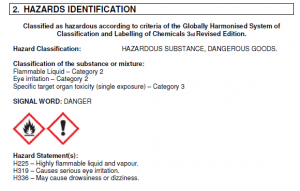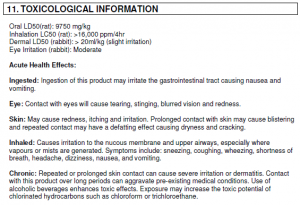
A Safety Data Sheet (SDS) is a document that provides detailed information about a chemical (both hazardous and not), including:the identity of the chemical product and its general ingredients
Why should I read the SDS?
The SDS is a key information resource for staff and managers in a business or those who may undertake the management of potential risks of a hazardous chemical in a workplace. It is important that workers read the SDS carefully and understand the information before working with any chemical. This is especially important for those chemicals which are hazardous, so that it can be safely handled, used and then stored or disposed of within the workplace.
Not all information about the hazards of a chemical or instructions for safe storage, handling and use may be provided on labels. In most cases, you will find the SDS containing much more in-depth information about a hazardous chemical than appears on the label. You can use the SDS in assessing specific risks associated with a chemical and in the training of staff on how to use a chemical safely. Always be sure to have the SDS easily accessible in the events of a spill or accident, so that you can quickly find the correct steps to follow.
An SDS which complies with the WHS Regulations contains the following 16 separate sections. These sections have specific information relating to the chemical being used, handled, stored, transported or disposed. Each section has relevance to different people in a workplace, and we have highlighted each section with an asterisk (*) for what most staff should focus on most before using a new product.
Section 1 – Identification:
Contains the product identifier or tradename, contact details of the manufacturer or importer responsible for supplying the chemical, and the telephone number to contact in case of an emergency.
*Section 2 – Hazard(s) identification
Gives details on the potential health and physical hazards of the chemical. This information can be used to help assess the risks to the health and safety of workers, other people nearby, and the environment. The information in this section should be consistent with the information on the label. In some cases there may be more information on the SDS than on the label.

Section 3 – Composition and information on ingredients
If the chemical is a mixture, this section should provide the information on the identity and proportions of hazardous ingredients in the mixture.
*Section 4 – First-aid measures
Describes the necessary first aid measures to be taken in case of an accident

*Section 5 – Fire-fighting measures
Gives specific information on fighting a fire involving the chemical, including the most suitable extinguishing media and other protective measures. Always have this available in case of emergency.

*Section 6 – Accidental release measures
Describes what actions need to be taken if there is an accidental release or spill of the chemical to minimise adverse effects on people, property and the environment.

*Section 7 – Handling and storage
Contains details on how to handle and store the chemical safely to minimise the potential risks to people, property and the environment.

*Section 8 – Exposure controls and personal protection
Provides information on control measures that can be used to reduce exposure. Example of these controls could be engineering controls, information on exposure standards and guidance on required personal protective equipment (PPE). For some products, PPE are a must before use to minimise or stop the chance of harm to yourself, or people in the area you work in.

Section 9 – Physical and chemical properties
Provides detailed information on the physical and chemical properties of the chemical, such as appearances, odour, pH, flash point, melting/boiling point or any other relevant physical data

Section 10 – Stability and reactivity
Contains details of any hazardous reactions that may occur if the chemical is used under certain conditions and details of any incompatible materials.
*Section 11 – Toxicological information
Provides detailed information on the toxicological properties of the chemical. This section is used primarily by medical professionals, toxicologists and WHS professionals. If there is an accident and someone needs medical attention, ALWAYS bring along a copy of the SDS for the medical professionals to review.

Section 12 – Ecological information
Provides detailed information on the ecological hazard properties of the chemical.
*Section 13 – Disposal considerations
Explains how the chemical should be disposed of correctly or recycled/reclaimed. While some chemicals have no issues with disposal, certain products may be toxic or hazardous to the environment. Certain sanitisers can also be a problem in large quantities if washed down the drain, as they can affect the bio-filters at water treatment sites.

Section 14 – Transport information
Contains basic classification information like UN number and transport hazard classes and packing groups that relate to the transport of the chemical by road, rail, sea or air. This information is key for people who are transporting chemicals between sites, or shipping out. Understanding this section can help avoid any issues when there is an accident and leakages occur.

Section 15 – Regulatory information
Provides advice on other international or national regulatory information specific to the chemical. This may include the Montreal protocol (ozone depleting substances), the Stockholm Convention (Persistent organic pollutants), Poisons scheduling or any other applicable Australian prohibition, notification or licensing requirements.
Section 16 – Any other relevant information
Provides any other information relevant to the preparation of the SDS. This includes the date of its preparation, a key or legend to abbreviations acronyms and references used. All SDS have an expiry of 5 years from the date of preparation, unless a newer version is created in this time.
Copyright © 2023 Advance Chemicals | T&Cs | Privacy | Sitemap | Website by Clever Digital